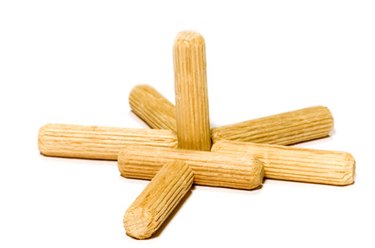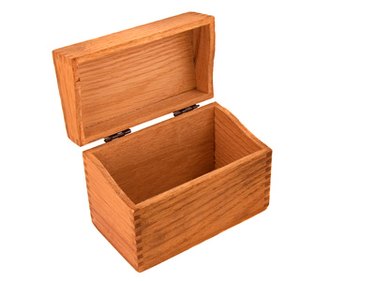
Many different types of joints can be used when working with wood, but some work better for certain projects. Not all joints are as easy to make, either, so you must balance the advantages of specific types with your ability to actually make that joint work to its best advantage.
Dowel Joint
Video of the Day
Dowel joints are quickly and easily made using a dowel drill bit. This is a good joint to use for strengthening corners and to prevent twisting. For best results, choose a dowel that is fluted because this will let the glue spread evenly throughout the joint.
Video of the Day
Butt Joint
Butt joints are one of the easiest wood joints to make, but you sacrifice strength unless you also reinforce them. Add strength by placing a corner block beneath where the two pieces of wood join or insert dowels to connect the lumber.
Rabbet Joint
Rabbet joints are popular for making drawers, boxes and cases. These joints are used in the furniture business because they are strong enough to put up with the constant forces of opening and closing. Rabbet joints are not difficult to make if you have power tools that can ensure precise measurements, but they can present problems if you are using hand tools with even slightly inaccurate measuring, according to "Reader's Digest New Complete Do-It-Yourself Manual."
Mortise and Tenon Joint
"The Illustrated Professional Woodworker" calls the mortise and tenon joint one of the most useful that a woodworker can master. This is also an easily cut joint if you have a dado cutter on a circular saw. Round-cornered, round mortise and square-corner mortise and tenon joints can also be made fairly quickly using a chisel. This is a strong enough joint to make table legs because the tenon is a thick slide of wood that fits into a hole created in the other piece of wood.
Miter Joint
The miter joint is useful for concealing unattractive end grain in a piece of lumber. This joint comes in handy for making items from furniture to picture frames that will be openly displayed. The downside is that the miter is not a very strong joint unless it is reinforced with dowels.
Biscuit Joint
Biscuit joints require the use of a tool known as a biscuit joiner for easy construction. This is a circular saw with a horizontal blade. The biscuit is just a funny name for a piece of flat wood that is used for reinforcement like a dowel. Biscuit joints are actually a good alternative to dowel joints if you want to conceal the means of reinforcement without sacrificing any strength.
Dovetail Joint

The main advantage of the dovetail joint is that it can give your woodworking project a flair and style that also allows you to showcase your woodworking talents. The disadvantage of using dovetail joints is that you will need to turn off the power tools and pick up your coping saw, block plane, utility knife and chisel to get the most ornamental effect. For less decorative dovetail joints, you can use a router with a dovetailing accessory according to "The Complete Book of Woodworking."